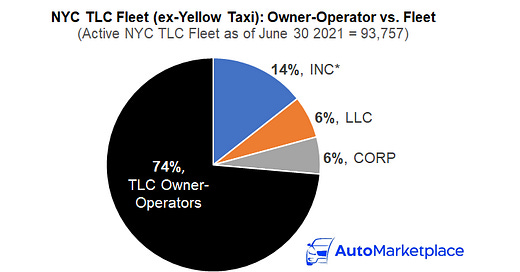

Discover more from AutoMarketplace
👛 Opinion: Will Raising Fares Backfire?
It's been a decade since yellow cab drivers got a raise, while NYC Uber/Lyft drivers also face increasing costs of doing business. Is it a good idea to raise fares in uncertain economic times?
AutoMarketplace.com NYC covers the for-hire transportation industry and automotive news. Check out AutoMarketplace.com on YouTube ▶️
⏱️Summary
📊 NYC TLC drivers need a raise, but fare increases need to be contextualized against the state of the economy: While inflation is hitting NYC TLC drivers across all sectors and a taximeter catchup is overdue, the state of the economy has to be considered in formulating and implementing fare increases. The average American / NYC passenger is also likely facing tighter financial conditions.
🚕 The post pandemic trip recovery currently taking place, could be impacted by overly aggressively fare increases: If trip volumes decline in a way that the increased incremental per trip income results in less total income for NYC TLC drivers, what is the actual benefit of fare increases?
🖼️ There are several ways to increase driver earnings: Framing driver earnings as ONLY a function of the taximeter or per mile / per minute calculations is flawed. There are other ways to increase driver earnings, without risking trip demand destruction.
🔒 TLC vehicle supply caps, help increase driver earnings: The medallion system was born of the Great Depression and as a way to protect NYC driver earnings through limiting for-hire vehicle supply. The recent announcement of up to 1,000 new “EV-only” FHV licenses needs to be closely tracked as 5,500+ medallions are inactive and an additional 4,500+ TLC plates remain in storage.
🏛️ Government surcharges & taxes, along with App “take rates”, need to be thoughtful (perhaps regulated) and can help increase TLC driver earnings: Driver earnings can increase if government taxation, including surcharges, and Uber/Lyft “take rates” are more thoughtful.
TLC Drivers Deserve A Raise, But There Are Multiple Ways To Achieve That
Let’s clarify something first. We believe all NYC TLC drivers deserve a raise and the opportunity to make a solid NYC middle class income. Tomorrow’s hearings on both yellow cab and NYC Uber/Lyft driver pay increases are important. Wage increases are undoubtedly overdue, especially for yellow cab drivers who’ve dealt with a flat taximeter for a decade. However, we believe the popular framing of the driver pay debate is somewhat flawed. For example, there are other ways to increase driver earnings without increasing passenger fares too much and risk killing trip volumes, especially in these uncertain economic times. From thoughtfully enforcing vehicle supply cap rules (i.e., plates in storage, FHV lease caps) to regulating government & Uber/Lyft “take rates”, driver earnings can be increased in several ways.
The point of this piece isn’t to make an argument against a TLC driver pay raise, but rather explore what’s missed when framing the debate too simplistically.
Sometimes When You Win, You Lose
Rosie Perez’s character’s famous dialogue with Woody Harrelson’s character in the movie White Men Can’t Jump is something worth noting as we discuss how NYC TLC driver wages can increase. Framing something too simplistically, doesn’t make a problem less complex, it makes the proposed solutions less effective.
“Sometimes when you win, you really lose. And sometimes when you lose, you really win. And sometimes when you win or lose, you actually tie. And sometimes when you tie, you actually win or lose. Winning or losing is all one organic mechanism, from which one extracts what one needs.”
- Gloria Clemente’s (played by Rosie Perez) wisdom in White Men Can’t Jump
Yes, we understand there are only so many opportunities where one can push for a wage increase. When the moment presents itself, the common strategy is to try to get every dollar you can. In addition, it’s also not lost on us that the last time yellow taxi fares were increased a decade ago, fears around the impact of higher fares were voiced (see video montage below from the New York Taxi Workers Alliance). After that fare hike, and pre-App companies becoming popular, there didn’t seem to be that many stories about yellow cab trip volume declining.
However, that misses several meaningful differences between those times and our current state of affairs, specifically:
The state of the economy, especially consumer inflation dynamics
A dominant and relatively effective taxi medallion system
Uber/Lyft’s current domination of NYC’s for-hire transport market
Less government taxes & surcharges
The State Of The Economy
NYC yellow cab taximeter and Uber/Lyft rates need to increase to reflect the increased costs of doing business. However, if you increase rates too much in an inflationary and likely recessionary economic environment (often referred to as “stagflation”), the recent past may not rhyme with the present as one may think it might. This sort of economic situation hasn’t really existed since the 1970s.
Basically the simplistic scenario analysis may look something like the below👇. In reality though, the state of the economy and consumer will influence the probabilities around which case likely plays out.

If you ask New Yorkers, tourists and browse social media, one comment that you’ll hear/see often is that yellow cabs are much cheaper than “Ubers”. We have also experienced this first hand on multiple occasions throughout 2021 and 2022. This, we believe and as the data shows, has led to a resurgence in yellow cab usage.

While the benefit of lower yellow cab pricing may not be obvious from NYC TLC trip data at first glance, if you actually measure the percent increases from the pandemic lows for NYC yellow taxi trips vs. Uber/Lyft, it’s clear that yellow cab trip volumes are recovering more rapidly, on a percentage basis, from the lows. To be fair, yellow cab trip volumes fell much more drastically than Uber/Lyft trips too, so one may argue the conclusion above is flawed without seeing more continued data as total trip numbers increase.
That being said, if you increase yellow cab prices to be more in line with Uber/Lyft fares, what does that do to trip volumes across for-hire sectors?
Uber/Lyft, taxi and other TLC bases, total trips collectively
Uber/Lyft vs. taxi on a relative trip market share basis
Uber/Lyft, taxi, other TLC bases on a relative trip market share basis
Etc., Etc.
This trip and market share loss fear among yellow cab drivers was expressed to CBS New York recently 🤔.
FHV Cap (aka TLC Plate Cap)
Yesterday, the NYC TLC released its biannual FHV License Pause & Determination Report. In that report, the TLC announced it planned to issue up to 1,000 more electric vehicle-only FHV Licenses (aka TLC plates). We will wait to pass judgement on this policy decision until we understand the TLC’s full plan, which they stated they would release soon. That being said, with more than 5,500 inactive taxi medallions and more than 4,500 other TLC plates in storage, this policy is somewhat confusing on its face. Why not create a mechanism to convert inactive medallions to EVs or set a deadline to remove TLC plates currently in storage, after which time those plates can be given to drivers “stuck” leasing or converted to “EV-only” plates?
Again, before really passing a hard judgement on the TLC’s policy decision to release up to 1,000 additional FHV licenses, we’ll wait for additional color from the regulator about plan specifics. One must remember the reason the yellow cab medallion system exists was related to limiting vehicle supply to help protect professional taxi driver earnings during the Great Depression (i.e., tough economy).
“The situation in the taxi industry was dire; frustrated cabdrivers turned their anger into violent protest and the demands for industry regulation increased. While regulation had already existed in some form with the Bureau of Licenses (aka the Police Department's “Hack Bureau”), many New Yorkers claimed that it was not enough. New York City's Board of Aldermen (the predecessor of the modern New York City Council), responded to calls for reform in 1937 by passing the Haas Act.
The Haas Act established the medallion system for New York taxicabs, which is still in use today. The Act's provisions included a limitation on the number of "medallion" licenses (and therefore, taxicabs) to the number that existed at the time. This number would be further reduced through attrition. As anticipated, this brought the supply of taxicabs closer to the level of service the public demanded, thus calming the fierce competition for customers. The stability the Haas Act brought to the taxi industry laid the foundation for the later successes of the war and post-war years.”
- NYC.gov
App “Take Rates” & Government Taxes & Surcharges
A “take rate” is a financial term for the commission Uber/Lyft “take” from each ride they facilitate (i.e., the broker fee). Given Uber and Lyft’s extremely dominant share of all NYC for-hire trips, the companies will argue the take rate is regulated via TLC minimum pay standards. However, minimum pay standards shouldn’t cap driver earnings to the upside, as that wasn’t the intention of the rule. In other words, if Uber and Lyft are always solving for how to just be compliant with the minimum pay formula and take the excess, is that really what you want occurring? Given Uber and Lyft additionally do not pay commercial vehicle insurance premiums in NYC, as they do in most other markets, a very strong argument can be made for more regulatory oversight on how much commission is being taken from TLC driver earnings.
Government taxes and surcharges also decrease driver earnings meaningfully. We aren’t saying or calling for the elimination of taxes or current surcharges like the Black Car Fund (BCF), which provide several useful employee-like benefits to independent TLC drivers. However, let’s agree that additional congestion tolls on an already heavily taxed industry would make the Sheriff of Nottingham even blush
Summary Thoughts
NYC TLC drivers need a raise to keep up with the increasing costs of doing business. However, increasing fares, which may also negatively impact trip demand given a weakening economy, is not the only way to increase driver earnings. Please be sure to dial-in to tomorrow’s TLC hearings on driver pay (click here for more details on how to dial-in tomorrow at 10AM or go the NYC TLC home page before 10AM).
As always, let us know your thoughts in the comments section below or by emailing us at info@automarketplace.com.
AutoMarketplace.com NYC covers the for-hire transportation industry and automotive news. Check out AutoMarketplace.com on YouTube ▶️














